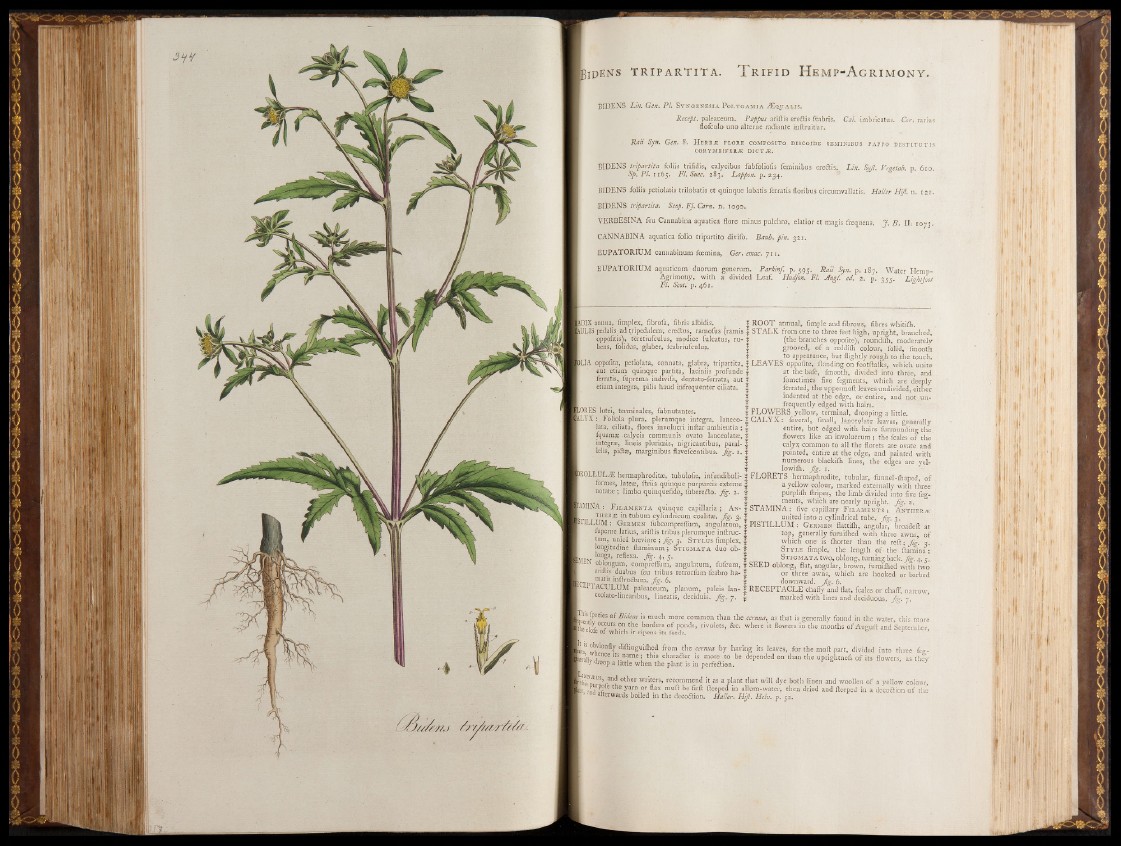
< 2 > f i § 0 £ %
W ID E N S TRIPARTITA. TRIFID H eMP-Ag RIMONY.
BIDENS Lin. Gen. Ph S y n g e n e s i a P o l y g am ia Æ qjjalis.
Recept. paleaceum. Pappus atiftis ere&is fcabris. Cal. imbricatus. Con rarius
flofculo uno alterne radiante inftruitur.
Rati Syn. Gen. 8'. H erbæ flore c o m p o s i t o discoïde seminibus pappo d e s t it u t is
CORYMB IFERÆ D1CTÆ.
BIDENS tripartita foliis trifidis, calycibus fubfoliofis feminibus eredtis. Lin. Syfi. Vegetab. p. 610.
Sp. PI. 1165. FI. Suec. 283. Lappon. p. 234.
BIDENS foliis petiolatis trilobatis et quinque lobatis ferratis floribus circümvallâtis. Haller Hijl. n. 121.
Blt)ENS tripartita^ Scop. FI. Carn. n. 1090.
VERBESINA feu Cannabina aquaticâ flore minus pulchro, elatior et magis frequens. j . B. II; 1073.
CANNABINA aquatica folio tripartito divifo. Bauh. pin. 321.
EUPATORIUM cannabinum foemina, Ger. emac. 711.
EUPATORIUM aquaticum duorum generum. Parkin/, p. 595. Rail Syn. p» 187. Water Hemp-
Agrimony, with a divided Leaf. Hudfon. FI. Angl. ed. 2. p. 355. Light foot
FI. Scot." p. 461. & J
BiDIX annua, fimplex, fibrofa, fibris albidis. f | ROOT annual, Ample and fibrous, fibres whitifh.
lULIS pedalis ad tripedalenr, eredlus, ramofus (ramis | STALK from one to three feet high, upright, branched,
oppofitis), teretiufculus, modice fulcatus* ru- t (the branches oppofite), roundifh, moderatelv
bens, folidus, glaber, fcabriufculus. | grooved, of a reddifh colour, folid, fmooth
I V t to appearance, but {lightly rpugh to the touch.
ILIA oppofita, petiolata, connatä, glabra, tripartita, | LEAVES oppofite, Handing on footftaiks, which unite
aut etiam quinque partita, laciniis j>rofunde | at the bafe, fmooth, divided into three, and
ferratis, fuprema indivifa, dentato-ferrataj aut t fometimes five fegments, which are deeply
fetiam. integraj pilis haud infrequenter Ciliata. | ferrated, the uppermoft leaves undivided, either
t indented at the edge, or entire, and not; uni
, I frequently edged with hairs.
I0RES lutei, terminales* fubnutantes. | FLOWERS yellow, terminal, drooping a little.
|LYX Foliola plura, plerumque Integra, lahceo- | C A L Y X : feveral, fmall, lanceolate leaves, generally
1 lata, ciliata, flores involucri inftar ambientia ; | entire, but edged with hairs furrounding the
fquama: xalycis communis ovato lanceolate, $ flowers like an involucrum; the fcales of the
integral, lineis plurimis, nigricantibus, paral- ^ calyx common to all the florets are ovate and
lei is, picke, marginibus flavefcentibus. fig. 1. ? pointed, entire at the edge, and painted with
I numerous blackifh lines, the edges are yel-
¥ lowifli. fig. 1.
ROLLULiE hermaphrodite, tubulof», infundibuli-| FLORETS hermaphrodite, tubular, funnel-fhaped, o f
formes, lute», ftriis quinque purpureis externe | a yellow colour, marked externally with threenotat
» ; limbo quinquefido, fübere&o. fig . 2. t purplifh ftripes, the limb divided into five feg-
L „ N*A; r> • . . I ments, which are nearly upright, fig . 2.
AivniMA : riLAMENTA quinque capillaria ; A n - $ STAMINA: five capillary F i l a m e n t s ; A n 'tfierje
Jjtii t m fRiE N tuI)Um CXlindricum coalite. fig. 3. | united into a cylindrical tube. fig. 3.
&ULLUM : G ermen fubcompreflum, angulatum, f PISTILLUM: G ermen flattifh, angular, broadeft at
füperne latms, ariftis tribus plerumque inftruc- | top, generally furnifhed with three awns, of
tum, unicä breviore ; fig. 3. St ylu s fimplex, | which one is fhorter than the reft; fig. o.
ongitudine ftaminum; St ig m a t a duo ob-| St y l e fimple, the length of-the ftamina ;
SUpm rC^eXa* S- I St ig m a t a two, oblong, turning back. fig. 4, r„
f lN objopgum, compreflum, angulatum, fufcum, J SEED oblong, flat, angular, brown, furnifhed with two
§. duabus feu tribus retrorfum fcabro ha- | or three awns, which are hooked or barbed
Ä 6* > I downward, fig. 6.
I'CLri ALULUM paleaceum, planum, paleis lan- | RECEPTACLE chaffy and flat, fcales or chaff, narrow,
ceolato-lmearibus, hneatis, deciduis. fig. 7. | marked with lines and deciduous, fig. 7. .
fuendPeCieS ° f Bl^ ns is rauch more common than the cernua, as that is generally found in the water, this more
KhPM r °CrUrs, the borders of ponds, rivulets, &c. where it flowers in the months of Auguft and September
■«e cioie of which it ripens its feeds. ’
f e « diftinguifhed from the cernua by having its leaves, for the moll part, divided into three feg-
lrall,7SenCe I?® Iiame; this charafter is more to be depended on' than the uprightnefs of its flowers, as thev
I y droop a little when the plant is in perfe&ion. y
f c 7 SVanf 0ther writers» recommend it as a plant that will dye both linen and woollen of a yellow colour,
* 3 Ä P the yarn or flax mu ft be firft fteeped in allum-water, then dried and fteeped in a deco&ion o f the
JH a«erwards boiled in the. decoftion. Haller. H iß. Helv. p. 52.